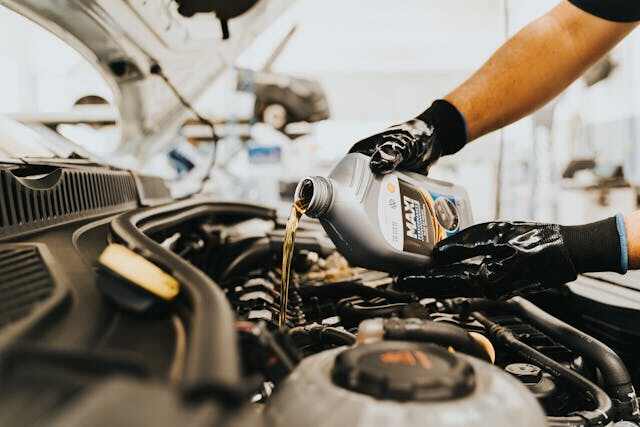Oil change keeps everything working well and helps prevent big problems down the road. But how often do you really need to get one? Let’s break it down.
Frequency:
First off, it’s important to understand that regular oil change is a must-do for your car’s health. Just like how you need to eat right and exercise to stay healthy, your car needs clean oil to keep its engine in great shape. Without it, things can start to go wrong.
So, how often should you get an oil change? Well, it depends on a few factors. One of the main things to consider is how much you drive. If you’re a frequent driver, you’ll need to get oil changes more often. On the other hand, if you don’t drive much, you might be able to stretch the time between oil change services a bit longer.
Most experts recommend getting an oil change every 5,000 to 7,500 kilometres. This interval makes sure that your engine stays well-lubricated and protected from wear and tear. However, some newer cars and synthetic oils may allow you to go longer between changes, up to 10,000 kilometres or more.
Another thing to consider is the type of driving you do. If you often drive in stop-and-go traffic, using a lot of breaks or driving in harsh conditions like extreme heat or cold, your engine may need more frequent oil changes. These conditions can put extra stress on your engine, causing the oil to break down faster.
Trust Your Car Manufacturer Recommendations
You should also pay attention to your car’s manufacturer recommendations. They know your car best and can provide guidance on how often to get an oil change. Check your owner’s manual for the recommended oil change interval for your specific make and model. These recommendations are based on extensive testing and research done by the manufacturer, making sure that your car receives the greatest care it needs to perform at its best. By following these guidelines, you know that your engine will remain well-maintained and protected against premature wear and tear.
What happens if you go too long without an oil change?
But what happens if you go too long without an oil change? Well, it’s not pretty. Over time, old oil can become dirty and contaminated with debris from your engine. This can lead to sludge buildup, which can clog vital engine components and cause them to wear out faster. Eventually, your engine could suffer serious damage, leading to costly repairs or even replacement.
On the flip side, can you change your oil too often?
While it’s unlikely to cause harm to your engine, changing your oil too frequently might be unnecessary. It can also be a waste of money, as oil changes can add up over time. Stick to the recommended interval for your car to make sure you’re not changing your oil more often than needed. What you can do quite often is checking engine oil levels and seeing if it needs a top up.
So there you go, oil change service is really important for keeping your car’s engine running smoothly. The frequency of oil changes depends on factors like how much you drive, the type of driving you do, and your car’s manufacturer recommendations. Stick to the recommended interval to ensure your engine stays well-lubricated and protected. And if in doubt, don’t hesitate to consult with a professional mechanic for guidance.

DIY Oil Change
If you’re handy with cars, you might be wondering if you can change your oil yourself. The answer is yes, you can! Doing your own oil changes can save you money and give you a sense of accomplishment.
- First things first, make sure you have the right tools for the job. You’ll need a wrench or socket set to remove the drain plug and oil filter, an oil filter wrench to remove the old filter, and a drain pan to catch the old oil. It’s also a good idea to have some gloves and safety glasses to protect your hands and eyes.
- Once you’ve gathered your tools, it’s time to get down to business. Start by warming up your engine for a few minutes to help the oil flow more freely. Then, jack up your car and secure it on jack stands to give yourself better access to the underside.
- Next, locate the oil drain plug underneath your car and place the drain pan underneath it. Use your wrench to loosen the drain plug and let the old oil drain out completely. While the oil is draining, locate the oil filter and use the oil filter wrench to remove it.
- Once all the old oil is drained out, it’s time to put everything back together. Replace the drain plug and tighten it securely, then install the new oil filter by hand and give it a good twist to make sure it’s snug. Now, it’s time to add the new oil. Consult your owner’s manual to find out how much oil your car needs and what type of oil to use.
- After you’ve added the new oil, start up your engine and let it run for a few minutes to circulate the fresh oil throughout the system. Then, check the engine oil level using the dipstick to make sure it’s at the correct level.
- Finally, don’t forget to dispose of the old oil properly. Most auto parts stores and recycling centres will accept used motor oil for recycling, so be sure to take it there instead of pouring it down the drain.
Of course, if you’re not comfortable doing an oil change yourself, that’s totally okay too. It’s always best to leave it to the professionals if you’re unsure or inexperienced. Just contact our mechanics in Tauranga and we’ll sort you out. But if you’re up for the challenge, DIY oil changes can be a rewarding and money-saving endeavour. So roll up your sleeves, grab your tools, and get ready to tackle your next oil change like a pro!
